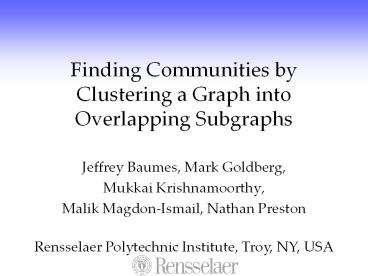Finding Communities by Clustering a Graph into Overlapping Subgraphs PowerPoint PPT Presentation
Title: Finding Communities by Clustering a Graph into Overlapping Subgraphs
1
Finding Communities by Clustering a Graph into
Overlapping Subgraphs
- Jeffrey Baumes, Mark Goldberg,
- Mukkai Krishnamoorthy,
- Malik Magdon-Ismail, Nathan Preston
Rensselaer Polytechnic Institute, Troy, NY, USA
2
Outline
- Introduction
- Algorithms IS and RaRe
- Experiments
- Conclusions and future work
3
Outline
- Introduction
- Algorithms IS and RaRe
- Experiments
- Conclusions and future work
4
What is a cluster?
- A cluster is a set of closely related objects,
not as closely related to the rest - Clustering is the development of a collection of
clusters - Traditionally, clustering is restricted to
partitioning into non-overlapping clusters
5
Overlapping clusters
- Partitioning is well researched many algorithms
and software packages exist - (Kernighan-Lin, k-means, hierarchical, CHACO)
- General clustering allows overlapping clusters
- Such clustering is natural in social networks
- Clustering in a general sense is not well-studied
6
Example
- Partitioning
- General Clustering
7
A new definition of a cluster
- Define a weight function (or density) W(C) for
every subset of objects, then maximize W locally - A cluster is defined as a set of objects whose
weight is larger than any set close to itthe
cluster is said to be locally optimal - A set is close to another if it may be derived
from the other by adding or removing one object
8
Weighting functions
pex
pin
pin pex
( )
( )
- We
Wi
Wp pin
W?
9
Outline
- Introduction
- Algorithms IS and RaRe
- Experiments
- Conclusions and future work
10
Iterative Scan (IS) algorithm
- Begins with some cluster seed
- Traverses nodes, adding or removing the node
while the cluster weight improves - Works for any choice of weight metric W
11
IS algorithm
12
Seed clusters
- IS depends on having good seed clusters
- These clusters should represent the entire
collection of objects - One option use an existing partitioning
algorithm to create the seed clusters - Another option create a new algorithm with a
global view to create seed clusters (possibly
overlapping)
13
Rank Removal (RaRe) algorithm
- Idea split the graph into components by removing
a few key players (high-rank nodes) - Then, add the nodes back into whatever clusters
they improve (possibly more than one)
14
RaRe algorithm
15
k-Neighborhood algorithm
- A naïve overlapping clustering procedure
- Selects random cluster centers
- Cluster contains all nodes distance at most k
from the center - Baseline for comparison with IS, RaRe
16
Outline
- Introduction
- Algorithms IS and RaRe
- Experiments
- Conclusions and future work
17
Experiments
- Runtime and quality analysis
- Compare algorithms on both real-world and
simulated inputs
18
Simulated input
- Random
- Group random
Preferential attachment
19
Runtime for simulated input
20
Quality for simulated input
21
Real-world graphs
- 575,600 node subset of the CiteSeer database
- E-mail communications among RPI community over
two days - Web graph of Malik Magdon-Ismails website
(www.cs.rpi.edu/magdon) - Newsgroup posts on alt.conspiracy
22
Quality for real-world graphs
23
Outline
- Introduction
- Algorithms IS and RaRe
- Experiments
- Conclusions and future work
24
Conclusions
- First overlapping clustering algorithms
successfully developed and tested - Local optimality is an intuitive criterion for
overlapping clusters - RaRe/2-N improved by IS was best overall
25
Future work
- More robust testing with various weight metrics,
and with known clusters - Develop new, more efficient algorithms for
clustering - Detect communities that evolve over time

